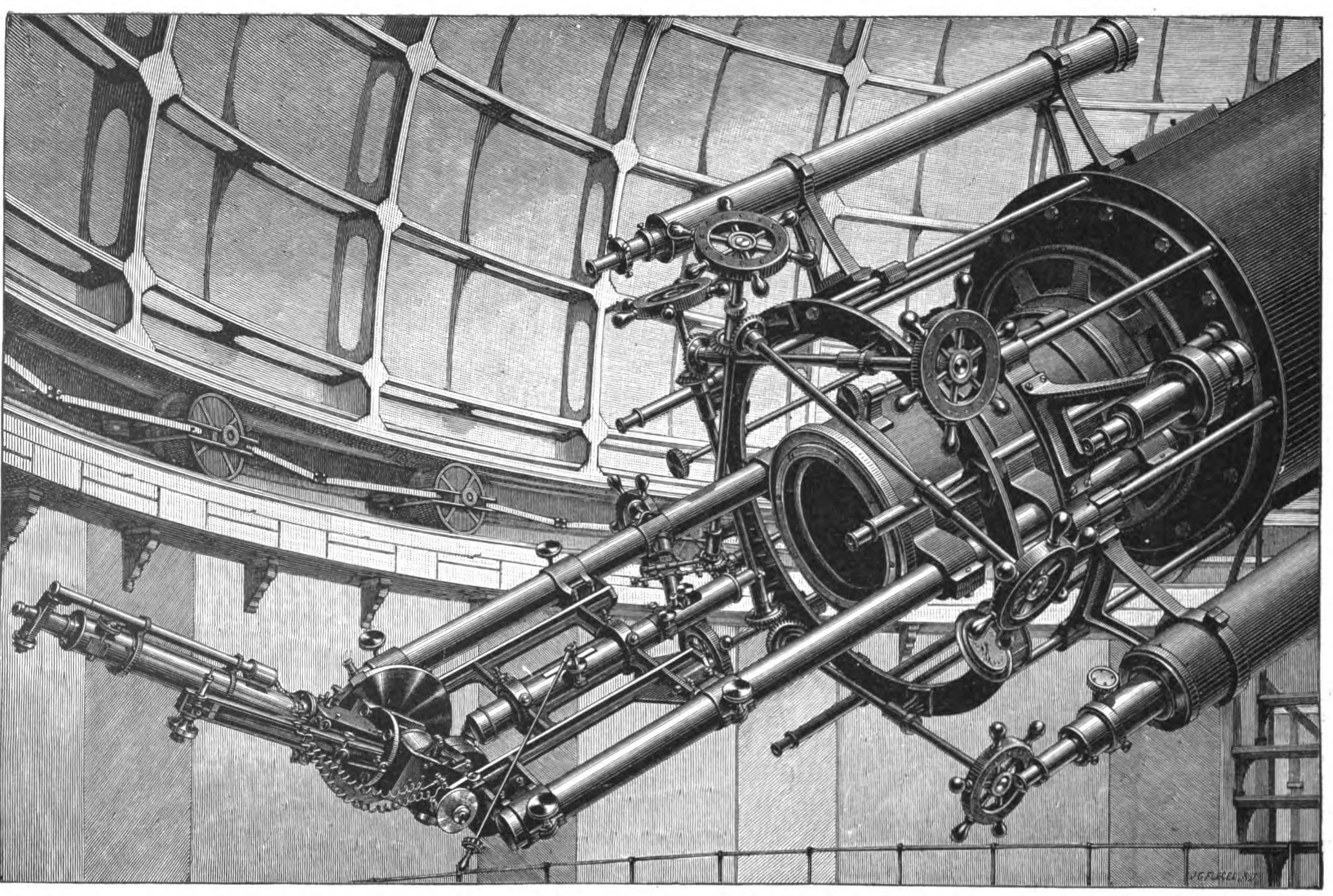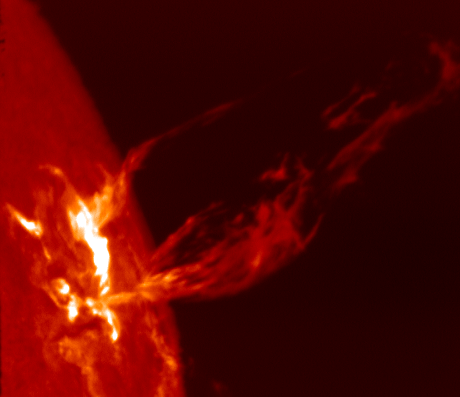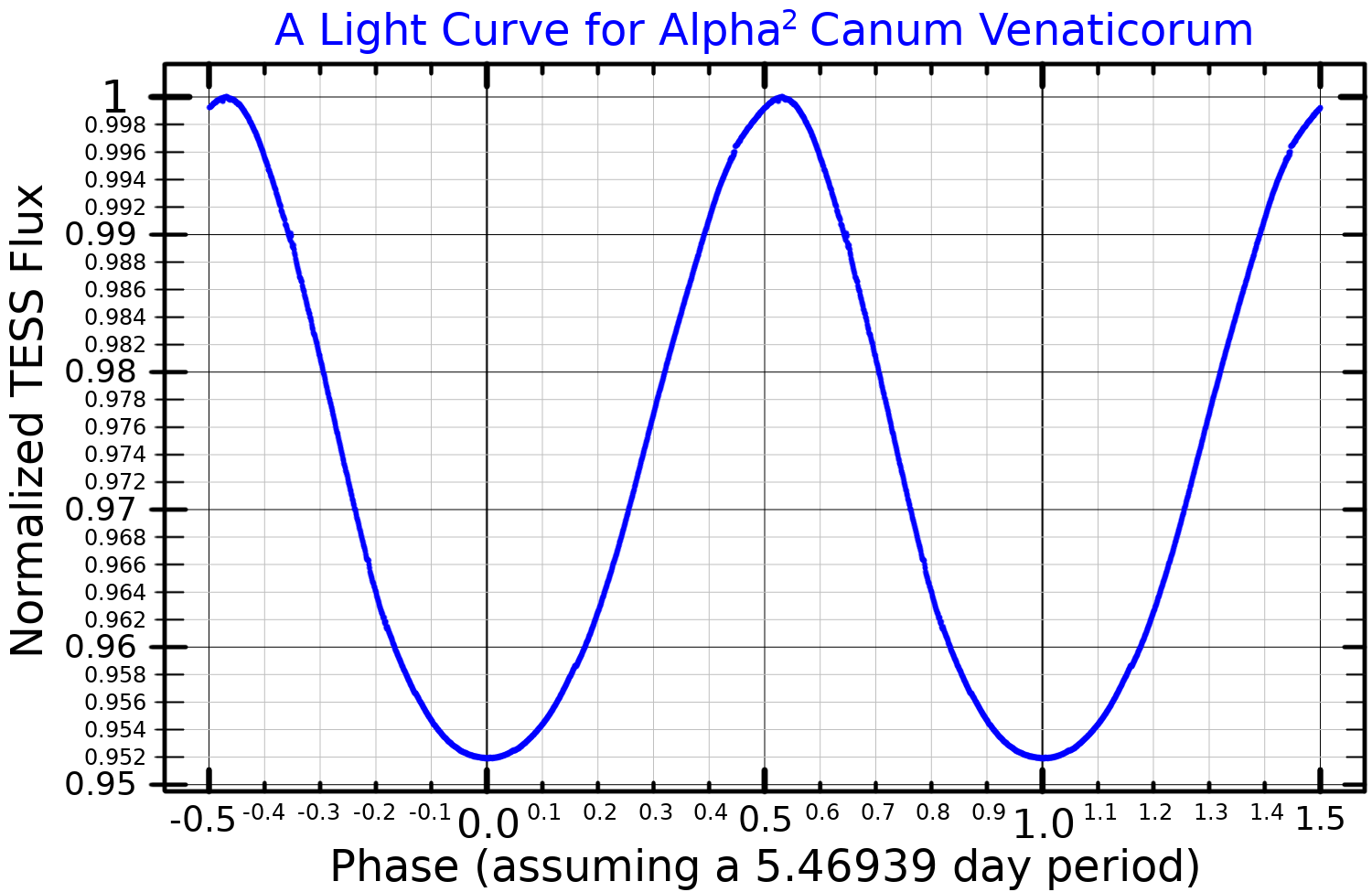|
Kappa Piscium
Kappa Piscium (κ Piscium) is a solitary, white-hued star in the zodiac constellation of Pisces. It is visible to the naked eye with an apparent visual magnitude of 4.94, forming the southeastern corner of the "Circlet" asterism in Pisces. Based upon a measured annual parallax shift of 21.25 mas as seen from Earth, it is located about 153 light years distant from the Sun. Appearing as a single point in the sky, it is easily split when viewed with a pair of binoculars, and displays three components. Kappa Piscium has an apparent magnitude of 4.87 at maximum brightness and 4.95 at minimum brightness, while the visual companions have apparent magnitudes of 9.96 and 11.20. This is an A-type main-sequence star with a stellar classification of . The suffix designation indicates it is a " chemically peculiar" Ap star that displays abnormal abundances of silicon, strontium, and chromium. It is an Alpha2 Canum Venaticorum variable with a weak active magnetic fie ... [...More Info...] [...Related Items...] OR: [Wikipedia] [Google] [Baidu] |
J2000
In astronomy, an epoch or reference epoch is a instant, moment in time used as a reference point for some time-varying astronomical quantity. It is useful for the celestial coordinates or orbital elements of a Astronomical object, celestial body, as they are subject to Perturbation (astronomy), perturbations and vary with time. These time-varying astronomical quantities might include, for example, the mean longitude or mean anomaly of a body, the node of its orbit relative to a reference plane, the direction of the apogee or Perihelion and aphelion, aphelion of its orbit, or the size of the major axis of its orbit. The main use of astronomical quantities specified in this way is to calculate other relevant parameters of motion, in order to predict future positions and velocities. The applied tools of the disciplines of celestial mechanics or its subfield orbital mechanics (for predicting orbital paths and positions for bodies in motion under the gravitational effects of other bodi ... [...More Info...] [...Related Items...] OR: [Wikipedia] [Google] [Baidu] |
Ap Star
Ap and Bp stars are chemically peculiar stars (hence the "p") of spectral types A and B which show overabundances of some metals, such as strontium, chromium and europium. In addition, larger overabundances are often seen in praseodymium and neodymium. These stars have a much slower rotation than normal for A and B-type stars, although some exhibit rotation velocities up to about 100 kilometers per second. Magnetic fields Ap and Bp stars have stronger magnetic fields than classical A- or B-type stars; in the case of HD 215441, reaching 33.5 k G (3.35 T). Typically the magnetic field of these stars lies in the range of a few kG to tens of kG. In most cases a field which is modelled as a simple dipole is a good approximation and provides an explanation as to why there is an apparent periodic variation in the magnetic field, as if such a field is not aligned with the rotation axis—the field strength will change as the star rotates. In support of this theory it has been no ... [...More Info...] [...Related Items...] OR: [Wikipedia] [Google] [Baidu] |
AB Doradus Moving Group
AB Doradus Moving Group is a group of about 30 associated stars that are moving through space together with the star AB Doradus. A moving group is distinguished by its members having about the same age, composition (or metallicity) and motion through space. Hence they most likely formed in the same location. This group is located about 20 parsecs from the Earth and is the closest known co-moving group. The average space velocity of this group has components of U = −8, V = −27 and W = −14 km/s. About 10 of these stars form a nuclear group within a volume roughly 10 parsecs across. The proximity of this moving group makes it useful for studies of shared stellar properties, as well as detection of companions through direct imaging. These can be used for refinement of young stellar models, for example. Age The age of the AB Dor Moving Group has been somewhat controversial, with quoted ages in the range of ~50 to ~150 Myr; recent work, howeve ... [...More Info...] [...Related Items...] OR: [Wikipedia] [Google] [Baidu] |
Oxygen
Oxygen is the chemical element with the symbol O and atomic number 8. It is a member of the chalcogen group in the periodic table, a highly reactive nonmetal, and an oxidizing agent that readily forms oxides with most elements as well as with other compounds. Oxygen is Earth's most abundant element, and after hydrogen and helium, it is the third-most abundant element in the universe. At standard temperature and pressure, two atoms of the element bind to form dioxygen, a colorless and odorless diatomic gas with the formula . Diatomic oxygen gas currently constitutes 20.95% of the Earth's atmosphere, though this has changed considerably over long periods of time. Oxygen makes up almost half of the Earth's crust in the form of oxides.Atkins, P.; Jones, L.; Laverman, L. (2016).''Chemical Principles'', 7th edition. Freeman. Many major classes of organic molecules in living organisms contain oxygen atoms, such as proteins, nucleic acids, carbohydrates, and fats, as ... [...More Info...] [...Related Items...] OR: [Wikipedia] [Google] [Baidu] |
Supernova
A supernova is a powerful and luminous explosion of a star. It has the plural form supernovae or supernovas, and is abbreviated SN or SNe. This transient astronomical event occurs during the last evolutionary stages of a massive star or when a white dwarf is triggered into runaway nuclear fusion. The original object, called the ''progenitor'', either collapses to a neutron star or black hole, or is completely destroyed. The peak optical luminosity of a supernova can be comparable to that of an entire galaxy before fading over several weeks or months. Supernovae are more energetic than novae. In Latin language, Latin, ''nova'' means "new", referring astronomically to what appears to be a temporary new bright star. Adding the prefix "super-" distinguishes supernovae from ordinary novae, which are far less luminous. The word ''supernova'' was coined by Walter Baade and Fritz Zwicky in 1929. The last supernova to be directly observed in the Milky Way was Kepler's Supernova in 160 ... [...More Info...] [...Related Items...] OR: [Wikipedia] [Google] [Baidu] |
Osmium
Osmium (from Greek grc, ὀσμή, osme, smell, label=none) is a chemical element with the symbol Os and atomic number 76. It is a hard, brittle, bluish-white transition metal in the platinum group that is found as a trace element in alloys, mostly in platinum ores. Osmium is the densest naturally occurring element. When experimentally measured using X-ray crystallography, it has a density of . Manufacturers use its alloys with platinum, iridium, and other platinum-group metals to make fountain pen nib tipping, electrical contacts, and in other applications that require extreme durability and hardness. Osmium is among the rarest elements in the Earth's crust, making up only 50 parts per trillion ( ppt). It is estimated to be about 0.6 parts per billion in the universe and is therefore the rarest precious metal. Characteristics Physical properties Osmium has a blue-gray tint and is the densest stable element; it is approximately twice as dense as lead and narrowly denser tha ... [...More Info...] [...Related Items...] OR: [Wikipedia] [Google] [Baidu] |
Stellar Spectrum
Astronomical spectroscopy is the study of astronomy using the techniques of spectroscopy to measure the spectrum of electromagnetic radiation, including visible light, ultraviolet, X-ray, infrared and radio waves that radiate from stars and other celestial objects. A stellar spectrum can reveal many properties of stars, such as their chemical composition, temperature, density, mass, distance and luminosity. Spectroscopy can show the velocity of motion towards or away from the observer by measuring the Doppler shift. Spectroscopy is also used to study the physical properties of many other types of celestial objects such as planets, nebulae, galaxies, and active galactic nuclei. Background Astronomical spectroscopy is used to measure three major bands of radiation in the electromagnetic spectrum: visible light, radio waves, and X-rays. While all spectroscopy looks at specific bands of the spectrum, different methods are required to acquire the signal depending on the frequency. ... [...More Info...] [...Related Items...] OR: [Wikipedia] [Google] [Baidu] |
Holmium
Holmium is a chemical element with the symbol Ho and atomic number 67. It is a rare-earth element and the eleventh member of the lanthanide series. It is a relatively soft, silvery, fairly corrosion-resistant and malleable metal. Like a lot of other lanthanides, holmium is too reactive to be found in native form, as pure holmium slowly forms a yellowish oxide coating when exposed to air. When isolated, holmium is relatively stable in dry air at room temperature. However, it reacts with water and corrodes readily, and also burns in air when heated. In nature, holmium occurs together with the other rare-earth metals (like thulium). It is a relatively rare lanthanide, making up 1.4 parts per million of the Earth's crust, an abundance similar to tungsten. Holmium was discovered through isolation by Swedish chemist Per Theodor Cleve and independently by Jacques-Louis Soret and Marc Delafontaine, who observed it spectroscopically in 1878. Its oxide was first isolated from rare-earth ores ... [...More Info...] [...Related Items...] OR: [Wikipedia] [Google] [Baidu] |
Uranium
Uranium is a chemical element with the symbol U and atomic number 92. It is a silvery-grey metal in the actinide series of the periodic table. A uranium atom has 92 protons and 92 electrons, of which 6 are valence electrons. Uranium is weakly radioactive because all isotopes of uranium are unstable; the half-lives of its naturally occurring isotopes range between 159,200 years and 4.5 billion years. The most common isotopes in natural uranium are uranium-238 (which has 146 neutrons and accounts for over 99% of uranium on Earth) and uranium-235 (which has 143 neutrons). Uranium has the highest atomic weight of the primordially occurring elements. Its density is about 70% higher than that of lead, and slightly lower than that of gold or tungsten. It occurs naturally in low concentrations of a few parts per million in soil, rock and water, and is commercially extracted from uranium-bearing minerals such as uraninite. In nature, uranium is found as uranium-238 (99. ... [...More Info...] [...Related Items...] OR: [Wikipedia] [Google] [Baidu] |
Absorption Lines
A spectral line is a dark or bright line in an otherwise uniform and continuous spectrum, resulting from emission (electromagnetic radiation), emission or absorption (electromagnetic radiation), absorption of light in a narrow frequency range, compared with the nearby frequencies. Spectral lines are often used to identify atoms and molecules. These "fingerprints" can be compared to the previously collected ones of atoms and molecules, and are thus used to identify the atomic and molecular components of stars and planets, which would otherwise be impossible. Types of line spectra Spectral lines are the result of interaction between a Quantum mechanics, quantum system (usually atoms, but sometimes molecules or atomic nucleus, atomic nuclei) and a single photon. When a photon has about the right amount of photon energy, energy (which is connected to its frequency) to allow a change in the energy state of the system (in the case of an atom this is usually an electron changing El ... [...More Info...] [...Related Items...] OR: [Wikipedia] [Google] [Baidu] |
Magnetic Activity
A stellar magnetic field is a magnetic field generated by the motion of conductive plasma inside a star. This motion is created through convection, which is a form of energy transport involving the physical movement of material. A localized magnetic field exerts a force on the plasma, effectively increasing the pressure without a comparable gain in density. As a result, the magnetized region rises relative to the remainder of the plasma, until it reaches the star's photosphere. This creates starspots on the surface, and the related phenomenon of coronal loops. Measurement The magnetic field of a star can be measured by means of the Zeeman effect. Normally the atoms in a star's atmosphere will absorb certain frequencies of energy in the electromagnetic spectrum, producing characteristic dark absorption lines in the spectrum. When the atoms are within a magnetic field, however, these lines become split into multiple, closely spaced lines. The energy also becomes polarized with a ... [...More Info...] [...Related Items...] OR: [Wikipedia] [Google] [Baidu] |
Alpha2 Canum Venaticorum Variable
An Alpha2 Canum Venaticorum variable (or α2 CVn variable) is a type of variable star. These stars are chemically peculiar star, chemically peculiar main sequence stars of stellar classification, spectral class B8p to A7p. They have strong magnetic fields and strong silicon, strontium, or chromium spectral lines. Their brightness typically varies by 0.01 to 0.1 Apparent magnitude, magnitudes over the course of 0.5 to 160 days. In addition to their intensities, the intensities and profiles of the spectral lines of α2 CVn variables also vary, as do their magnetic fields. The periods of these variations are all equal and are believed to equal the period of rotation of the star. It is thought that they are caused by an inhomogeneous distribution of metals in the atmospheres of these stars, so that the surface of the star varies in brightness from point to point. The type-star which this class is named after is Cor_Caroli#α2_Canum_Venaticorum, α² Canum Venaticorum, a star in ... [...More Info...] [...Related Items...] OR: [Wikipedia] [Google] [Baidu] |







